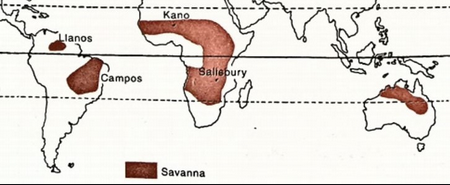Climatic Type: The Tropical Marine Climate
Climate (Temperature & Precipitation):
- Steady rainfall because of the influence of Trade winds throughout the year
- Presence of both, Orographic and Convectional rainfall
- No distinct dry period
Distribution:
- Tropical Marine climate is experienced along Eastern margins of Tropical lands. This includes regions like Central America, West Indies, north-eastern Australia, Philippines, parts of East Africa, Madagascar, Guinea Coast and eastern Brazil.
Vegetation & Wildlife:
- Deciduous trees which shed their leaves.
- Durable hardwoods like teak, Sal, acacia, varieties of eucalyptus, bamboo etc.
- Tropical monsoon forests are more open, less luxuriant and less diverse.
- Monsoonal vegetation varies from forests to thickets and from savanna to scrubland.
Major Tribes: They practice Shifting cultivation have different names. Those are:
Region | Practice of Shifting cultivation |
Malaysia | Ladang |
Myanmar | Taungya |
Thailand | Tamrai |
Java | Humah |
Philippines | Caingin |
Sri Lanka | Chena |
Africa | Milpa |
Central America | Milpa |
Climatic Type: The Savanna or Sudan climate
Climate (Temperature & Precipitation):
- Extreme diurnal range of temperature is its characteristic feature.
- The highest temperature just before the rainy season.
- Alternate hot, rainy season and cool, dry season.
- Length of rainy season and the amount of annual rainfall decreases as we move away from the equator.
- Prevailing Trade winds which are strongest in Summer, bring rain to the coastal districts.
Distribution:
- This is a transitional type of climate between equatorial forests and trade wind hot deserts.
- It is confined within the tropical region. It is best developed in west African Sudan, east Africa and southern Africa above the Tropic of Capricorn. The Savanna region known is ‘Kano’ and ‘Salisbury’.
- In Australia, it is stretched from west to east, north of the Tropic of Capricorn.
- In South America, Orinoco basin which is Savanna region north of the equator is known as ‘Llanos’ and south of the equator containing Brazilian highlands is known as ‘Campos’.
![]()

Vegetation:
- Characterized by Tallgrass and short trees.
- Grassland is also called as ‘parkland’ or ‘bush-veld’.
- Deciduous trees shade their leaves in cool, dry season e.g. acacias
- In Savanna, lands grass is tall and coarse.
- With decreasing rainfall, savanna merges into thorny scrub. Australian scrubland includes species like mallee, mulga, spinifex grass and other bushes.
Wildlife:
- Both herbivorous and carnivorous animals exist in Savanna.
- Herbivorous animals include zebra, antelope, giraffe, deer, gazelle, elephant and okapi.
- Carnivorous animals include tiger, leopard, hyaena, panther, jaguar, jackal, lynx and puma.
- It is an animal paradise with the presence of other giant diverse species which include reptiles, mammals, alligators, giant lizards, rhinoceros, hippopotamus, snakes, birds, moths, butterflies and insects.
Major Tribes:
- Masai tribe of East African plateau are cattle pastoralists. They are confined to Kenya, Tanzania and Uganda.
Hausa tribes are settled, cultivators. They mainly live in Bauchi plateau of northern Nigeria.
Free मे पढ़े GS/GK Study Notes और अपनी तैयारी को मज़बूत करे




Comments
write a comment